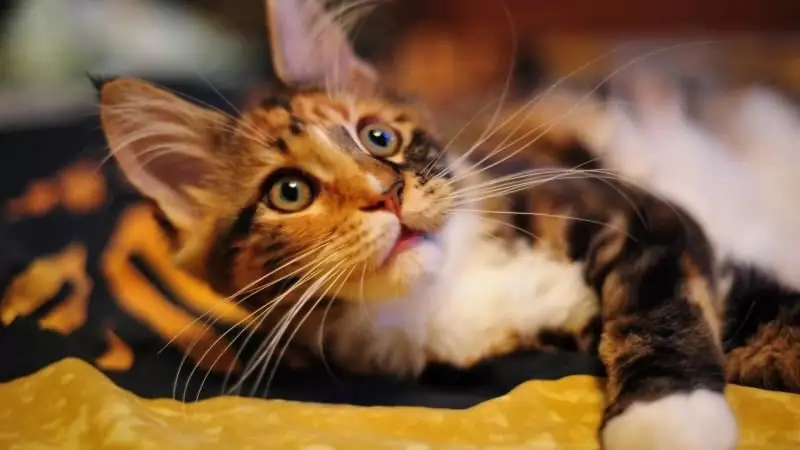
Table of contents:
- Neutering a cat: home care after surgery
- Why sterilization is needed
- Methods for neutering a cat
- Cat after sterilization in a veterinary clinic
- Pet care at home
- Condition and behavior of the cat in the first days after surgery
- Possible complications
- Changes in a cat's life after surgery
- Veterinarian advice
- Cat owners reviews
- Author Bailey Albertson [email protected].
- Public 2024-01-17 22:26.
- Last modified 2025-06-01 07:32.
Neutering a cat: home care after surgery
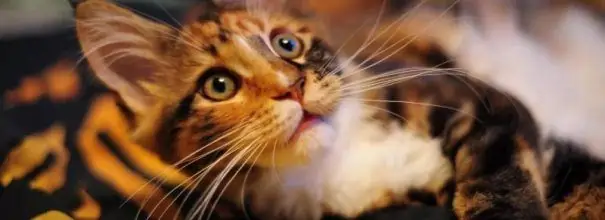
Sometimes the owner of a cat that is not involved in breeding is kept from sterilizing by fear for the health of the pet, the state after the operation and during the recovery period. Having the necessary information will allow you to make the right decision.
Content
- 1 Why sterilization is needed
-
2 Methods for neutering a cat
2.1 The importance of postoperative cat care
-
3 Cat after sterilization in a veterinary clinic
- 3.1 Day of surgery: leave the pet in the hospital or take it home
- 3.2 How long does it take for a cat to recover from anesthesia
-
4 Pet care at home
- 4.1 Transporting the cat
- 4.2 Coming out of anesthesia
- 4.3 Pain relief
- 4.4 How to drink
- 4.5 Rules for the use of blankets and collars
-
4.6 Treatment of seams
4.6.1 Photo gallery: types of postoperative skin sutures
- 4.7 Antibiotic therapy
- 4.8 Video: Caring for a cat after spaying
- 5 Condition and behavior of the cat in the first days after surgery
- 6 Possible complications
- 7 Changes in a cat's life after surgery
- 8 Advice from veterinarians
- 9 Cat owner reviews
Why sterilization is needed
If the cat is not involved in breeding, then sterilizing it is a smart decision.
Sterilization has a number of advantages for both the cat itself and its owner:
-
Allows you to control the number of cats. A cat that has free access to the street, and therefore the ability to mate in heat, can bring 5 litters of kittens annually, and most of them will not be able to find a home.

Cats in the garbage Sterilization reduces the number of stray animals
- Interrupts the effects of the stress caused by the animal's sexual behavior on the cat itself and on the rest of the family. During the sexual hunt, the cat is under the influence of hormones, so it rages, screams, and can also mark the territory with urine and behave aggressively. Heat and periods of sexual behavior occur in cats several times a year, and getting rid of them will make the life of the pet and her family more comfortable and happy.
- Reduces the risk of developing breast tumors. According to researchers - up to 50% and more if sterilization is carried out at an early age - before the first estrus.
- Eliminates the risk of contracting sexually transmitted diseases, such as venereal sarcoma.
- Reduces the likelihood of contracting lethal infections of cats - viral immunodeficiency and viral leukemia - from stray animals, since the need for communication with relatives in a spayed cat is significantly reduced.
-
Increases life expectancy. In neutered cats, it is 2-3 years higher than in those cats that regularly bring offspring. Sharp fluctuations in the level of sex hormones in the blood, as well as changes in the body that accompany pregnancy, childbirth and feeding, negatively affect the cat's health and shorten its life.

Sterilization benefits poster Sterilization has many positive aspects for both the animal and its owner.
Sterilization also has disadvantages:
- The need for anesthesia. Sterilization in cats is an abdominal operation that requires a violation of the anatomical integrity of the abdominal wall and removal of the organs of the reproductive system, therefore, it requires appropriate pain relief. The degree of anesthetic risk (the effect of anesthesia on the animal's body) is determined individually; in general, young, healthy cats have a low risk, while older cats with underlying medical conditions are at a much higher risk. But at the same time, the degree of anesthetic risk is lower during a planned sterilization operation than in an emergency, for example, removal of the uterus with pyometra. Modern veterinary anesthesiologists know and combine different methods of administering anesthesia, reducing the risks for patients.
- Obesity risk. In the absence of hormonal fluctuations, the cat becomes calmer, lazy, and her appetite increases. This can result in overweight and an increase in the load on the heart with the subsequent development of heart failure. Therefore, veterinarians strongly recommend switching sterilized cats to ready-made diets that are low in fat and carbohydrates, or revising natural cat food.
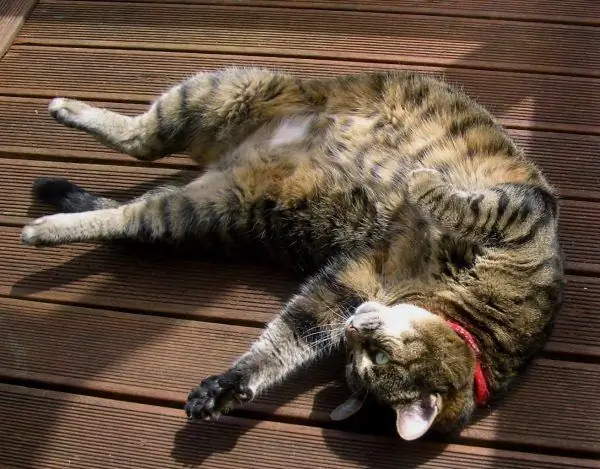
After sterilization, the cat becomes calmer and lazier, so it needs to reduce the calorie intake, otherwise obesity will develop.
Methods for neutering a cat
The scientific literature describes methods of radiation and reversible chemical sterilization of cats (using the drug Suprelorin), but they have not been introduced into veterinary practice, since they have no obvious advantages over surgical sterilization. Therefore, talking about spaying a cat always means performing an operation.
Methods for surgical sterilization of a cat are divided according to:
-
The volume of surgical intervention:
- Ovariohysterectomy - the uterus and its appendages (tubes and ovaries) are removed. This operation is also called castration. It allows you to reliably solve problems with sexual behavior in cats, diseases of the uterus and its appendages, both inflammatory and oncological. Modern veterinary medicine considers this type of intervention to be optimal.
-
Ovariectomy - only the ovaries are removed. It was previously performed on young healthy cats and was considered more gentle due to the reduced volume of surgical intervention. As a result, estrus stopped and the risk of cysts and tumors was reduced, but the uterus is a hormone-dependent organ, and hormonal dysregulation due to the removal of the ovaries often turns into pyometra - an accumulation of pus in the uterine cavity against the background of endometritis - inflammation of its mucous membrane of a dyshormonal nature. Therefore, veterinarians are now avoiding this volume of surgery. It is this operation in essence that is sterilization.

Cat with pyometra When the ovaries are removed, hormonal regulation is disrupted, which threatens the accumulation of pus in the uterus (pyometra)
-
Operational access:
-
Access along the white line of the abdomen - is performed most often, with the incision located along the midline of the abdomen within the area bounded by the navel and the last pair of nipples. In this case, muscle injury does not occur, since the access passes through the aponeurosis - a tendon formation, which guarantees minimal blood loss and quick recovery. After this type of surgical approach, a skin suture with a length of 1.5-5 cm remains.

White line of the abdomen in cats White line of the abdomen - the area from the navel to the last pair of nipples
- Lateral approach - rarely used by veterinarians, since its only advantage is the ability to neglect the care of skin sutures due to the small size of the incision. At the same time, during this type of operation, there is a poor view, the intervention is associated with muscle injury, the recovery after which is more difficult than after the surgical injury of the aponeurosis. Typically, this approach is used for oophorectomy in stray cats, which are released outside after the end of the anesthesia.
- Video laparoscopic access requires special equipment and high qualifications of a surgeon, therefore it is not used in all clinics. At the same time, there are no incisions in the skin and abdominal wall, since the operation is performed through punctures: gas is injected into the abdominal cavity in order to raise the abdominal wall and provide an overview for the surgeon, as well as space for the instruments; the introduction of a camera for visual control and manipulators allowing to perform the planned volume of surgical intervention are performed. With this access, the surgical trauma of the abdominal wall, blood loss and the risk of infection are minimal. Either single stitches or small wounds covered with medical glue remain on the skin, if small instruments were used. This access is shown not to all cats, for example, it is not used for heart and lung diseases,since the injected gas raises the dome of the diaphragm and makes it difficult for the organs of the chest cavity, which can cause decompensation of their functions.
-
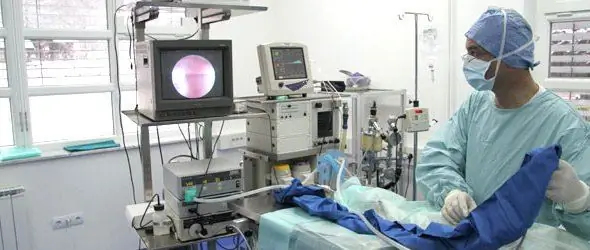
The least traumatic for sterilizing a cat is laparoscopic surgery.
The importance of postoperative cat grooming
Postoperative care of a cat determines the further success of its treatment, since at this time its condition needs to be controlled and monitored, and it is also necessary to carefully follow the instructions of the veterinarian. This will reduce the risk of postoperative complications and speed up the cat's recovery. Caring for a cat will require time from the owner, as well as certain knowledge and skills.
Cat after sterilization in a veterinary clinic
When planning to sterilize a cat, you should weigh your possibilities for caring for her and self-administration of medical procedures at home. Most modern veterinary clinics have a hospital where cats can be treated and cared for.
Day of surgery: leave the pet in the hospital or take it home
If during the operation there are unforeseen complications both from the side of anesthesia and from the side of the operation itself, the cat will be left under the supervision of the staff until its condition stabilizes at the insistence of the veterinarian. The same decision can be made if the pet has concomitant pathology or due to its advanced age. In most cases, the decision whether to take the cat home immediately after surgery is made by the owner.
Inpatient care benefits:
- constant professional monitoring of the cat's condition is carried out, which is of particular importance in the presence of concomitant pathology;
- professional care is carried out, there are no difficulties with the implementation of medical appointments;
- there is no need for the owner to spend a lot of time and effort caring for the pet, since this is not always possible;
- the only alternative for cats without a master;
-
if the clinic is located far from home and there is no way to provide the cat with gentle transportation conditions, the issue can be especially acute in the cold season.

A cat in a hospital In the hospital, the cat will be carried out on time the necessary procedures prescribed by the veterinarian after the operation
Disadvantages of inpatient care:
-
dependence of the quality of care on the conscientiousness of the clinic staff, therefore, you should pay attention to:
- the reputation of the clinic, reviews about it;
-
conditions for keeping animals:
- temperature conditions - temperature must be below 20 to C;
- cell size;
- food;
- constant presence of caring personnel;
- severe stress for an animal in an unfamiliar environment;
- the possibility of contracting an infectious disease even in a vaccinated animal, since stress and the presence of an operational injury reduce immunity;
- additional costs for the host.
How long does it take for a cat to recover from anesthesia?
The time a cat comes out of anesthesia is influenced by:
- his appearance;
- body weight of the cat;
- the number of medications administered during anesthesia;
- individual characteristics of the cat itself.
Modern anesthesia is highly manageable, and in most cases the cat is returned to the owner when it is already awake and can make independent movements. Most clinics prefer to return the animals 3-4 hours after the operation, providing the necessary medical support and supervision during this time.
If the pet was returned to the owner immediately after the operation, you should not rush to leave the clinic. It is advisable to stay for half an hour or an hour to make sure that the cat's condition is stable, that it has positive dynamics in recovering from anesthesia, as well as that there are no early postoperative complications, for example, bleeding from a vessel that was unsuccessfully tied during surgery. The cat usually begins to try to move independently 2-3 hours after the end of the operation, but the full effect of anesthesia stops only after 2 days.
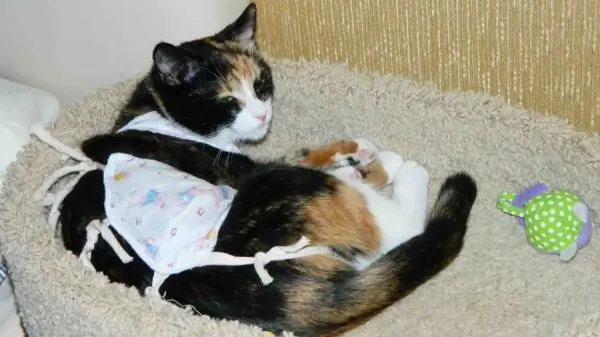
The sleeping cat should be placed on a soft and low surface to avoid injury from a fall
Pet care at home
At home, the cat is looked after, the prescribed medical procedures are carried out, and its condition is monitored. In unclear situations, you should seek the advice of a veterinarian.
Transporting the cat
The cat is transported from the clinic in a carrier, on the bottom of which an oilcloth is laid, since a cat that is recovering from the action of anesthesia may have involuntary urination. On top of the oilcloth, you need to lay a warm soft cloth, put the cat on its side and wrap it up, due to the action of anesthesia, its thermoregulation is impaired and it is prone to hypothermia. Particular attention should be paid to this in the cold season, it is possible to place a wrapped bottle of hot water on the back of the cat, but not in the abdomen in the seam area, as this can provoke bleeding from it. The position on the side will protect against possible suffocation with vomit in the event of vomiting, which occurs when coming out of anesthesia.
It is highly undesirable to transport the cat in your arms, because, being under the residual effect of anesthesia, it can break loose, fall, run away in an unknown direction, or show aggression and injure the owner.
Coming out of anesthesia
Even if an already awake cat was returned to the clinic, it should be remembered that getting out of anesthesia is a long process, and the effect of the drugs injected stops completely after 2-3 days.
The cat should be placed in a calm, but at the same time, easily accessible and easily visible place without drafts. The air temperature should be at least 20-24 o C. The cat is placed on its side on a low and soft surface, covered with a disposable absorbent diaper and covered. It is advisable that if the cat continues to sleep, turn it from side to side every 2 hours and massage the paws to improve blood circulation. Do not place your cat on a chair or sofa as it may fall and be injured.
If the effect of anesthesia is still pronounced, and the cat sleeps with half-open eyes, measures should be taken to protect them from drying out. Saline can be instilled periodically, but it is best to use an eye ointment or gel, such as Korneregel, as they protect the eyes from drying out longer and better.
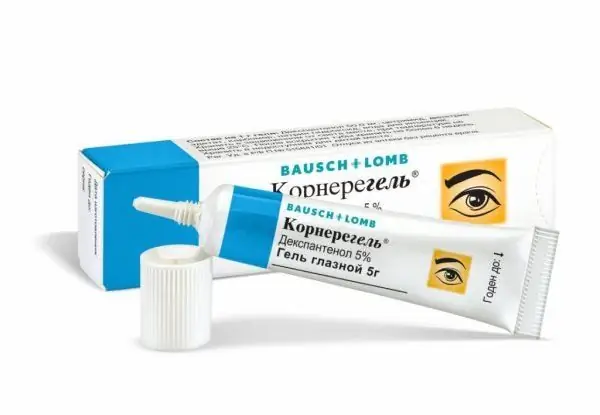
Korneregel heals the surface of the eye and prevents it from drying out
During this period, the cat may have vomiting, involuntary urination, slight muscle tremors - this is completely normal and is explained by the residual effect of medications.
After 2-3 hours, the cat will begin to move, while the coordination of movements is expected to be impaired, changes in behavior are also possible, excitement and even aggression are possible. During this period, you should protect the cat from injuries and falls:
- create a safe environment around her;
- close the windows, as it can easily fall out;
- hinder her attempts to climb onto the sofa, the cat's "tree", and other hills.
If the house has a large cage, you can place your pet in it for this time. So the cat will be safe, and the owner will not need to constantly monitor its movements. Impaired coordination of movements is restored up to 12 hours after the end of the operation.
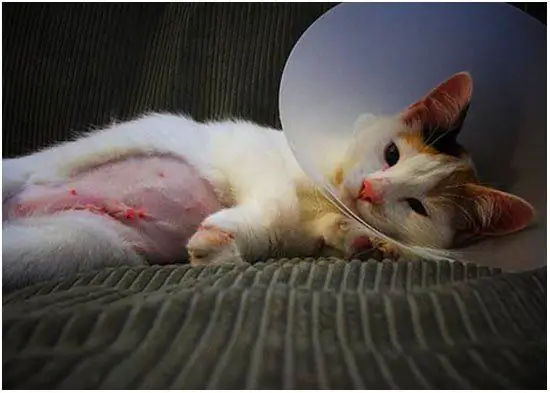
The eyes of an anesthetized cat are open, so eye gels or ointments should be used to prevent corneas from drying out.
Anesthesia
Pain relievers are usually prescribed by the veterinarian when the cat is returned to the owner. When leaving the clinic, you should clarify when the next dose should be administered.
Adequate pain relief is very important for the cat's early recovery, especially the first two days after surgery. Cats don't tend to complain and endure pain in silence. Signs of inadequate pain relief include:
- the cat's aggression when trying to communicate with her;
- lack of appetite;
- lack of physical activity;
- the position of the cat lying on its stomach with tucked up paws, can look tensely in front of itself;
- dilated pupils;
- increased heart rate.
If you have problems with the medication prescribed by your doctor, you can use other drugs that are acceptable for pain relief in cats. Cats should not be given human drugs - Analgin, No-shpu, Paracetamol.
Drugs that a cat can:
-
ketoprofen (Ketofen, Ainil);

Ketofen Ketofen is a non-steroidal anti-inflammatory drug with an analgesic effect
- Firocoxib (Previcox);
- meloxicam (Loxicom).
Usually, anesthesia is carried out for 3-5 days 1-2 times a day, and in the first two days the drugs are injected.
How to drink
After anesthesia, the cat is thirsty, so in the first hours you can drink it from a pipette, moistening the drying mucous membrane of the mouth with water. When the cat begins to gradually activate and move independently, she is given free access to water. Restriction of the drinking regime in a pet that is in a semi-drowsy state is associated with the risk of vomiting and blocking the airways.
Rules for the use of blankets and collars
Usually, the owner takes the pet, already dressed in a blanket and collar, designed to protect the skin seams from damage by the cat. They must be worn for 10 days before removing the stitches. Unlike a collar, the blanket does not differ in strength, and it is better to buy a second one of the same for a change, without leaving the clinic, since the sizes of blankets from different manufacturers are very different.
A cat, coming out of anesthesia, will make a lot of effort for the first 1-2 days to get rid of the blanket and collar, which should not be allowed, because then it will lick the stitches, which will turn into suppuration.
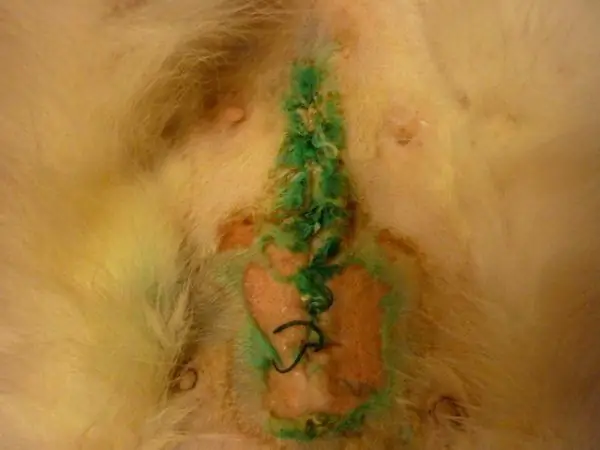
Licking the seam leads to its suppuration
The blanket must be periodically adjusted by adjusting the ties on the back of the animal. It must cover the seams securely and be dry. It is important to ensure that she does not rub the cat in the groin and axillary areas, as well as to monitor its integrity, since some cats, trying to get to the seams, are able to shed holes in the blanket.
The collar is selected in the clinic according to the size; it should be wiped periodically. For feeding and drinking, cats pick up utensils that are smaller in diameter than the collar and place them on low stands so that the pet has the opportunity to get to food and water.
If the collar and blanket are damaged, they should be replaced.
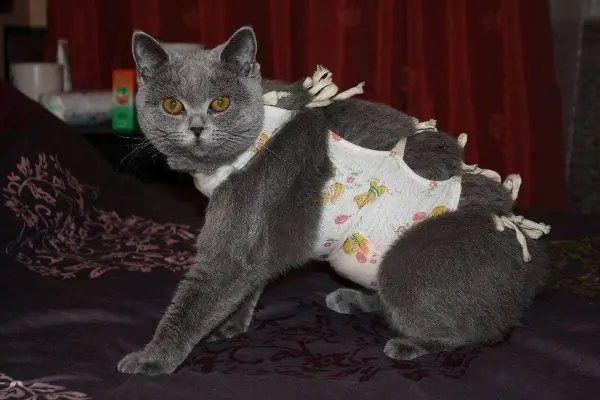
The blanket is necessary to protect the skin seams from licking
Seam processing
The treatment of the seam is performed against the background of the action of anesthetic drugs, otherwise the cat will be aggressive. It is better to do this with an assistant who keeps the cat on its hind legs, since the animal will not voluntarily agree to lie on its back. The lower part of the blanket is untied and the seams are processed.
The order of processing seams:
- The area of the seams, and then the adjacent areas of the skin, is gently wiped with a tampon dipped in a solution of hydrogen peroxide, which removes impurities and has an antimicrobial effect.
- Remove the remaining peroxide by drying the skin with a napkin.
- Gently rub the seam area with a swab with an aqueous solution of chlorhexidine or Miramistin.
- Close the seams with a wide dry cloth. It is not necessary to fix it with an adhesive plaster - it causes severe irritation in animals.
Sutures are processed every day for the first 5 days, then every other day. They are removed on the 10th day. Often veterinarians use absorbable sutures that do not require removal.
The first 2-3 days after the operation, the suture looks swollen, this is a normal tissue reaction to the surgical injury. There may be a release of a few drops of blood, but more often an ichor seeps between the seams - a yellowish liquid, slightly colored with blood. Sometimes on the first day after the operation, blood may be sucked from the suture. As a rule, the cause is a small skin vessel injured during surgery. Such bleeding can be stopped on your own by applying a napkin to the seam and pressing for 20 minutes. You can also enter Dicinone: 0.5-1 ml s / c or i / m. It is important to stop bleeding, even minor, because it will turn into a hematoma in the seam, and it is prone to suppuration. If you cannot stop bleeding from the seam on your own, you should contact your veterinarian.
Photo gallery: types of postoperative skin sutures
-

Interrupted single sutures to the skin - Interrupted single seams must be removed
-

Intradermal suture - Intradermal sutures are often applied using absorbable sutures, so it is necessary to clarify if sutures need to be removed
-

Punctures from trocars on the skin of a cat - Skin wounds after video laparoscopic access can be simply sealed with medical glue
Antibacterial therapy
Antibiotic therapy for routine sterilization usually consists of prophylactic administration of a broad-spectrum drug 1-2 times:
- the first introduction is carried out on the day of surgery in the clinic;
- the second - the next day after the operation during a routine follow-up examination by a veterinarian.
If necessary, your doctor may include antibiotics in your cat's regimen.
Video: caring for a cat after sterilization
Condition and behavior of the cat in the first days after surgery
The first days after the operation, it is important to monitor the basic parameters of the cat's vital activity. This will allow you to help her in time in case of complications. You need to watch out for:
- Body temperature. Immediately after the operation temperature can be lowered to 1.5 of C, which is accompanied by fever, cat therefore necessary to warm. In the future may increase the temperature as the body's response to surgical trauma, but maintaining it above the 39.5 of C after 5 nights stay, conducted transaction requires consultation of a veterinarian.
- Appetite. Food is usually offered to the cat the next day after the operation in an amount not exceeding 50% of its usual portion. If, after the first meal, the cat vomits, this is a consequence of anesthesia. Since the operation is a factor that predisposes to the development of constipation, fermented milk products and vegetables, for example, beets, broccoli, should be added to the cat's food, mixed with meat in a blender. If the pet eats ready-made feed, then you can offer veterinary diets for the operated animals. Lack of appetite for more than 3 days is a reason to contact your veterinarian.
- By urinating. It is important to anesthetize the cat well, since reflex urinary retention is possible against the background of intact pain syndrome. To find out how many times and how many times your cat urinates, remove litter from the litter box. For the first time, the pet may need help - you need to help her get into the tray, holding her tummy with a loop of a towel. At the very first urination, there may be a small admixture of blood in the urine - this is blood from the uterine stump, poured into the vagina during the operation, and later into the urine. If you change the amount of urine, as well as its appearance, you should immediately contact your veterinarian.
-
Defecation. For the prevention of constipation, adequate pain relief and diet correction are important. If there is no stool for 3 days, a laxative should be given (Bimin 1 ml / kg cat weight).

Bimin The drug Bimin is a mild laxative based on vaseline oil
Possible complications
Complications of spaying a cat are rare, but it's worth knowing about them:
- Bleeding into the abdominal cavity. Its cause is incomplete ligation of uterine vessels or poor-quality electrocoagulation of smaller vessels. At the same time, the cat's pulse quickens, the mucous membranes turn pale, abdominal pain persists even 3-4 days after sterilization, she meows and refuses to eat and move. This is a formidable complication, and it requires a second operation to stop bleeding and flush the abdominal cavity from the remnants of the poured blood.
- Suppuration of the skin suture. Signs of suppuration of the skin suture usually appear by the 5th day: the edges of the suture turn red, swell, a cloudy purulent discharge appears. The seam must be treated with Levomekol ointment and the cat must be shown to the doctor to assess the need for antibiotic therapy.
- Postoperative hernia. A rare complication after sterilization. The reason is the formation of a defect in the abdominal wall, through which part of the internal organ exits under the skin. A hernia looks like a bulge on the abdominal wall of a standing cat, which disappears when it is supine. When palpating in the projection of the postoperative scar, a defect is found - a hernial orifice. If adhesions are formed, then the hernia may not be repaired. Hernia treatment is only surgical, its main danger is the possibility of infringement, necrosis of the injured organ and the development of peritonitis. Suppuration of the postoperative suture predisposes to the occurrence of a hernia.
- Divergence of postoperative sutures. An extremely rare complication of sterilization. The reason is always the same - peritonitis with paresis (paralysis) of the intestine, which may be caused by accidental trauma to the intestine during surgery.
Sometimes in the area of the suture, you can see seals, which are common and represent excessive growths of granulation tissue - a feature of the healing process in a particular cat. These lumps usually go away one month after the operation and are not a complication of it.
Changes in a cat's life after surgery
After sterilization, the cat becomes calm, more friendly and affectionate, enjoys communicating with family members and playing, since she is no longer bothered by hormonal surges.

After spaying, the cat becomes more sociable and friendly.
After the operation, it is necessary to reduce the calorie content of the cat's diet by cutting down the fat and carbohydrate content in it. There are ready-made food for sterilized cats.
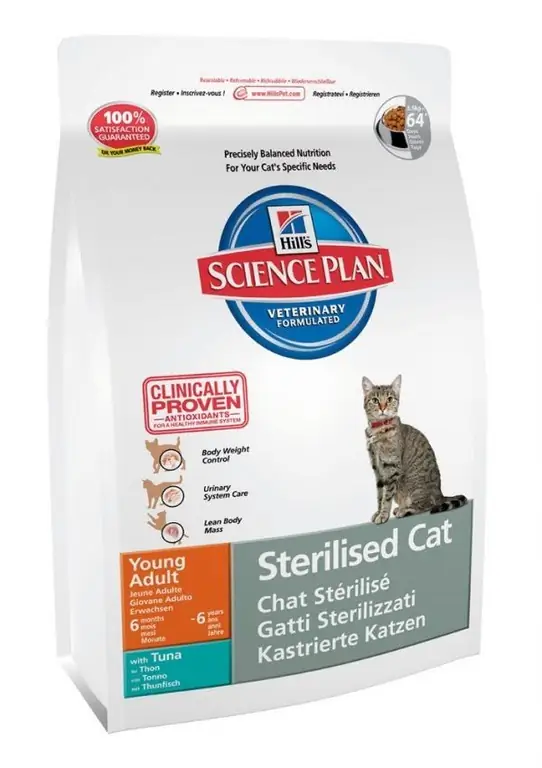
Many brands have veterinary pet food lines that include products for neutered animals
Veterinarian advice
Cat owners reviews
Sterilization of a cat allows you to lead a more comfortable and happy life both for herself and her family, excluding periods of sexual heat from the life of the pet. The operation extends the life of the cat by 2-3 years, reducing the risks associated with its health. The disadvantages of sterilization include the need for surgery and correction of the diet after it.
Recommended:
How Long Does A Cat's Pregnancy Last, What Determines The Period Of Carrying Kittens (including The First Time), Caring For A Pregnant Pet
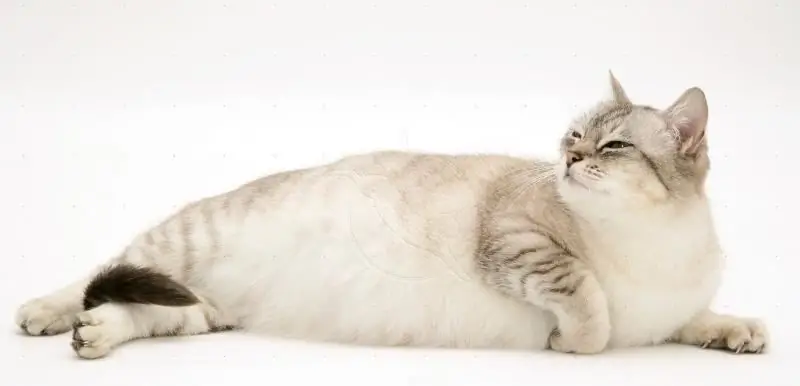
How long a pregnancy lasts in cats and what it depends on, including if the cat is pregnant for the first time. Stages of pregnancy. Possible problems
Mating Cats And Cats: How Mating Takes Place, At What Age Should The First Mating Of Pets And Other Advice To Owners
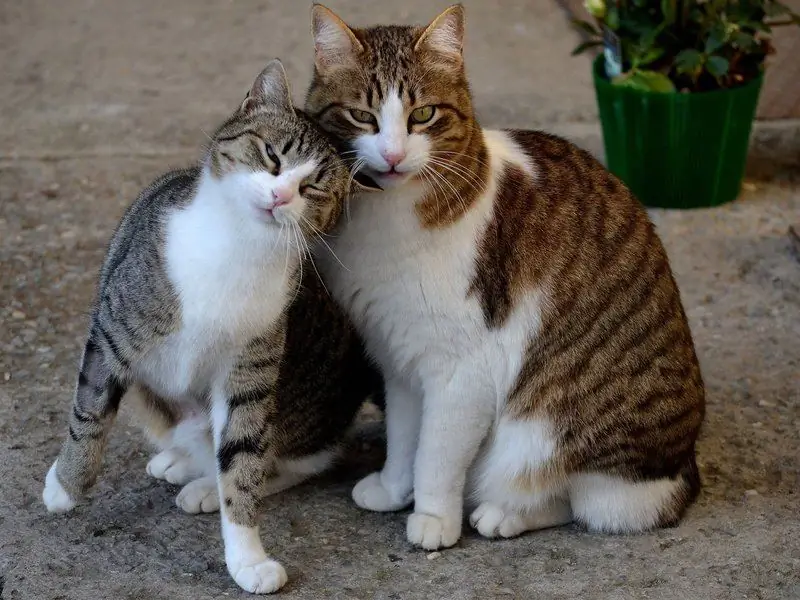
The timing of puberty in cats and cats. First mating rules. Preparation for mating. Choosing a partner. Mating process of cats. Signs of pregnancy. Reviews
Blanket For A Cat: After Sterilization, From Rain And Others, How To Choose, Do It Yourself, Use A Postoperative Bandage
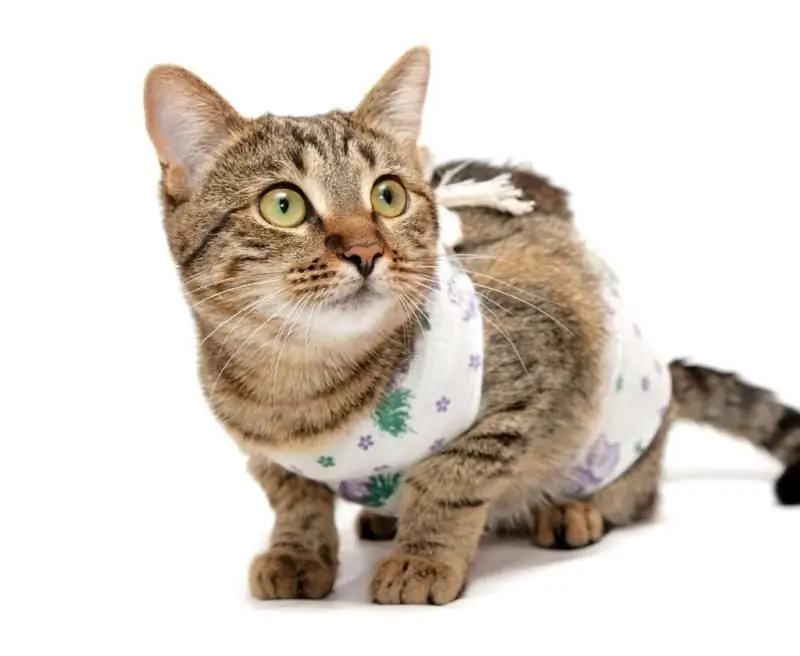
Types of blankets for cats: postoperative, raincoat, warm. How to put on a blanket after sterilization and when to remove it. How to make a blanket with your own hands
The World's Oldest Domestic Cat And Cat: What Determines The Life Of A Pet, How To Extend It, Rating Of Animals - Long-livers, Photos
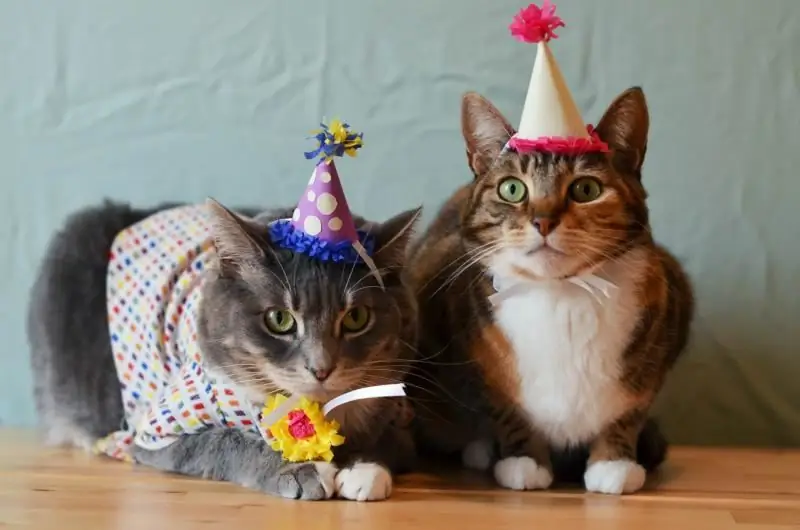
Average lifespan of cats. Rating of long-lived cats from the Guinness Book of Records. How to extend the life of a pet
How Many Days After The Act Can You Find Out About Pregnancy, Learn About Conception By The Test, Before The Delay And After

When the first signs of pregnancy appear. When to take a pregnancy test. Blood test for hCG. Ultrasound to detect pregnancy. External signs
